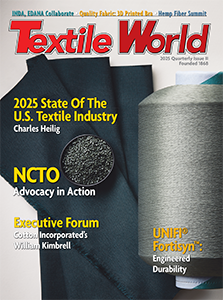Upland cotton research and marketing company Cotton Incorporated, Cary, N.C., has developed three textile finishing technologies to improve protection, comfort and other performance levels in cotton sheeting and top-of-bed products without altering cotton’s soft, comfortable hand
and easy-care characteristics. According to the company, the technologies offer added value beyond high thread counts touted of late by manufacturers and retailers when promoting the quality of various bedding products.
Enduring Comfort
The new endure™ finish — a variation of Cotton Incorporated’s Tough Cotton™ apparel finish — is formulated especially for home textiles. The company reports the finish strengthens the fabric, significantly increasing the durability of wrinkle-free, easy-care cotton sheets and other home textiles — not only improving abrasion resistance and color retention, but also controlling shrinkage and improving wrinkle resistance.
Although endure is initially targeted to bedding applications, David Earley, manager, textile market development for home products, noted that with some further development, the technology could apply to upholstery or decorative fabrics as well.
“Cotton doesn’t have the durability of some of the heavy-duty nylons or polyesters that really exhibit extended wear,” he said. “This would be a way to get cotton into those types of markets because you could extend the wear-life of the cotton fabrics by making them more abrasion-resistant and maintaining their original color longer.”

Cotton Incorporated’s endure™, repel™ and Wicking Windows™ finishing technologies improve
various performance attributes of cotton sheeting and top-of-bed products.
Breathable Barrier
Stain and water repellency is the primary advantage offered by repel™, a hydrophobic finish that also renders the fabric quick-drying — an energy-saving plus. Earley pointed out that fabric treated with repel also retains its breathability and hand.
“Even though repel is water- and stain-repellent, it’s not a coating on the fabric,” he explained. “It’s a durable finish that’s applied and helps maintain the original breathability of the cotton. It creates a barrier that water and food molecules can’t pass through, but water vapor is small enough that it can pass through. If you do get a stain on the fabric, or water, it’s very easy to blot it away.”
Cotton Incorporated has shown repel initially as a finish for top-of-bed textiles such as duvet covers and comforters, but it too has potential applications in other home textiles, such as upholstery or decorative fabrics and tabletop textiles, according to Earley. In addition, repel may
be used in conjunction with endure to provide combined benefits of both finishes in a single product.
Cool, Dry Comfort
Wicking Windows™ moisture-management technology augments a cotton fabric’s comfort levels by transporting moisture away from the skin through the fabric to the opposite side, where it is dispersed over a wider surface area — while also providing quick-drying benefits. The finish, originally introduced for cotton athletic and casual apparel applications, also reduces the cling factor in cotton fabrics because the side next to the skin remains dry (See “Quality Fabric Of The Month,” TW, March 2005).
Earley said Wicking Windows could be applied to woven or knit sheets. “The key benefit is moving moisture away from the body to the other side of the fabric so that your sleep environment stays cool and dry and more comfortable,” he said. Comparing the finish’s benefit in sheets to that in apparel, he noted: “Obviously you’re not going to have as much moisture when you’re sleeping, but the human body does give off water vapor while you’re resting. If that amount of moisture can be controlled and moved away from the body, our thought is that it can contribute to a more comfortable sleep environment.”
Cotton Incorporated is developing marketing materials for all three technologies to help manufacturers and retailers promote products offering their benefits to consumers. Earley said a number of manufacturers have expressed interest in the technologies.
For more information about endure™, repel™ and Wicking Windows™, contact David Earley (919) 678-2220.
April 2006





